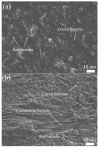Innovative Coating-Etching Method of Biocarrier Fabrication for Treating Wastewater with a Low C/N Ratio
- PMID: 35893972
- PMCID: PMC9330803
- DOI: 10.3390/polym14153010
Innovative Coating-Etching Method of Biocarrier Fabrication for Treating Wastewater with a Low C/N Ratio
Abstract
A novel method was used to fabricate the bio-carrier with both a high specific surface area and good compatibility. The results of monitoring the growth of biofilms at a low C/N ratio (0.83) showed that resulting carrier-PLA-cavity offered certain advantages for biofilm growth by providing an appropriate microenvironment for bacterial growth in wastewater treatment. The biofilm on carrier-PLA-cavity grew and updated faster than the naked-carrier. The biomass and thickness of biofilms growing on carrier-PLA-cavity were 10 kg/m3 and 500 μm, respectively. From the wastewater tests, 90% of the total nitrogen was removed via simultaneous nitrification and denitrification (SND) by the biofilm biomass attached to carrier-PLA-cavity, compared to 68% for the naked-carrier. The COD removal efficiency values of the carrier-PLA-cavity and naked-carrier were 94% and 86%, respectively. The microbial community analysis of carrier biofilms showed that Halomonas was the most abundant genus, and heterotrophic nitrification and denitrification were responsible for nitrogen removal in both reactors. Notably, this method does not require any complicated equipment or structural design. This novel method might be a promising strategy for fabricating biocarriers for treating wastewater with a low C/N ratio.
Keywords: biodegradable polymers; biofilm; nitrate removal; solid carbon source; wastewater treatment.
Conflict of interest statement
The authors declare no conflict of interest.
Figures














References
-
- Tarjányi-Szikora S., Oláh J., Makó M., Palkó G., Barkács K., Záray G. Comparison of Different Granular Solids as Biofilm Carriers. Microchem. J. 2013;107:101–107. doi: 10.1016/j.microc.2012.05.027. - DOI
-
- Felföldi T., Jurecska L., Vajna B., Barkács K., Makk J., Cebe G., Szabó A., Záray G., Márialigeti K. Texture and Type of Polymer Fiber Carrier Determine Bacterial Colonization and Biofilm Properties in Wastewater Treatment. Chem. Eng. J. 2015;264:824–834. doi: 10.1016/j.cej.2014.12.008. - DOI
Grants and funding
LinkOut - more resources
Full Text Sources

